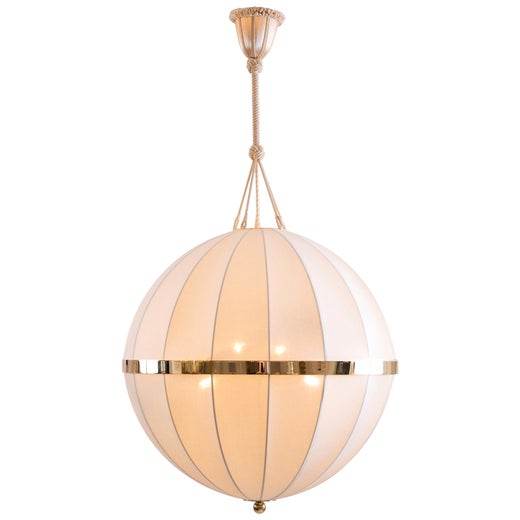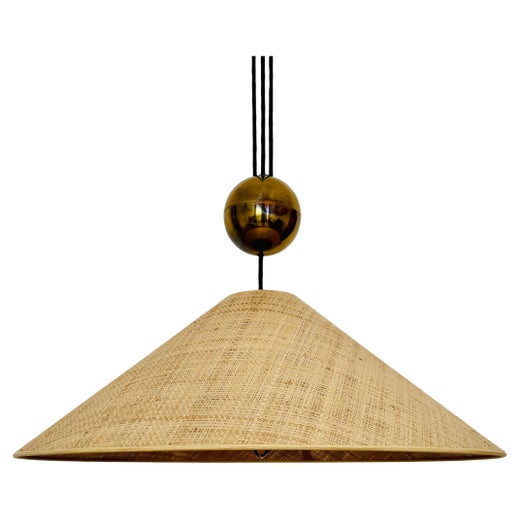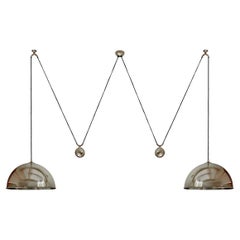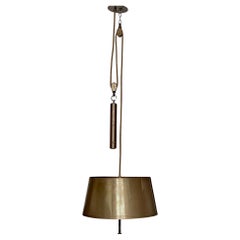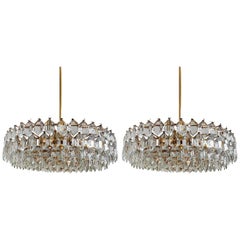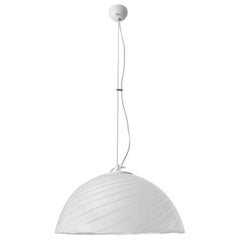Austrian Vintage Large Adjustable Counterweight Pendant Lamp Loos Hoffmann
About the Item
- Creator:Josef Hoffmann (Designer),Adolf Loos (Designer)
- Dimensions:Height: 7.88 in (20 cm)Diameter: 19.69 in (50 cm)
- Style:Mid-Century Modern (Of the Period)
- Materials and Techniques:
- Place of Origin:
- Period:
- Date of Manufacture:1950s-1960s
- Condition:Wear consistent with age and use.
- Seller Location:Berlin, DE
- Reference Number:Seller: 2018009401stDibs: LU2013311933643
Josef Hoffmann
The Austrian architect Josef Hoffmann was a central figure in the evolution of modern design, and a leader in an aesthetic movement born in Europe in the late 19th century that rejected florid, extravagant ornamentation in favor of a new emphasis on simplicity of line.
As a founder of the Vienna Secession — a union of artists and designers determined to upend Austria’s artistic conservatism — and later, a founder of the turn-of-the-century Wiener Werkstätte (in English: the Viennese Workshops), a design cooperative that produced superbly crafted furniture and housewares, Hoffmann was a pioneering practitioner of what would become a fundamental principle of modernism: that good design is a way of life.
Hoffmann came of age amidst a shift in the culture of the applied arts, as a conservative order that looked only to the past for inspiration was pushed aside. But what, exactly, would replace that order was in question — and Hoffmann’s career embodies the developing patterns of design’s new spirit. His architectural work reflects his time as a student of the Vienna architect Otto Wagner, who disdained excessive decoration and employed new materials such as steel girders and reinforced concrete to create buildings with airy, open interiors full of light.
As a designer of furniture and interiors, Hoffmann was consistently open-minded about the aesthetics he explored. He was an early adherent of the flowing, organic forms of the Art Nouveau design movement that began to flourish in the late 1880s — but by the opening of the Wiener Werkstätte in 1903, Hoffmann’s designs embraced the beauty of geometry in pieces that feature grids and angular forms.
Hoffmann’s greatest works reflect his ability to combine seemingly conflicting design visions into coherent wholes. His architectural masterpiece, the Stoclet Palace in Brussels, has an exterior that groups together simple geometric forms and spacious interiors marked by subtly naturalistic design details that lend rooms an air of charm and geniality.
Hoffmann’s signature furniture design is an adjustable lounge chair — the Sitzmaschine (1905) — that marries a curving frame with square and rectangular back- and side rests. This piece, like so many others by Hoffmann, reflects a groundbreaking, forward-thinking appreciation for the union of different looks and sources that marks the best of interior design in our own day. Moreover, items offered on 1stDibs — which range from enameled silver jewelry, to silver flower vase baskets and other decorative objects, to sofas, lighting pendants and sconces — testify to the astonishing breadth of Hoffman’s creative pursuits. He was truly a giant of design.
Adolf Loos
Essentially dubbed the Frank Llyoyd Wright of Europe by Wright himself, Adolf Loos possessed a talent for architecture and interior design as potent as his outspoken criticism of Art Nouveau and excessive ornamentation. A forerunner of the International Style, Loos exercised immense restraint in his building projects as well as his designs for chairs, tables, storage pieces and other furniture, and wrote prolifically on his disdain for taking a decorative approach to architecture.
The son of a stonemason and sculptor, Loos was born in 1870 in what is now Brno in the Czech Republic. He studied architecture in Dresden in 1889, completed a year of military service and moved to the United States by 1893. He visited the World’s Columbian Exposition in Chicago and came to appreciate the American approach to design over his three-year stay before returning to Vienna.
An avid proponent of simplicity, Loos hated fluff above all else. In his best known essay, “Ornament and Crime,” he states “the evolution of culture is synonymous with the removal of ornamentation from objects of everyday use” — a principle evident in both his architectural work and furniture. His writing was profoundly influential for practitioners of the International Style that would emerge later as well as the likes of prolific Swiss-born French architect and modernist prophet Le Corbusier.
Loos challenged the prevailing architecture and decorating styles of his time, and disliked the ornate work associated with the Vienna Secession and Gesamtkunstwerk — the concept of a house as total work of art — an ideal pursued by a collective born from the Secession called the Wiener Werkstätte. To Loos, design should prioritize function, and any ornamentation devoid of a structural purpose was childish and unnecessary.
Loos’s furniture — alongside the work of fellow Austrian architect Josef Hoffman — was the subject of an exhibition at the Museum of Applied Arts in 2014. His architecture projects, including the Viennese Goldman and Salatsch building, the Austrian Steiner House and the Villa Müller in Prague, are celebrated by design enthusiasts all over the world.
Find vintage Adolf Loos seating, lighting and other furniture on 1stDibs.
You May Also Like
Vintage 1950s Austrian Mid-Century Modern Chandeliers and Pendants
Brass
Vintage 1960s German Mid-Century Modern Chandeliers and Pendants
Metal
Vintage 1960s German Mid-Century Modern Chandeliers and Pendants
Metal
Vintage 1960s German Mid-Century Modern Chandeliers and Pendants
Metal
Vintage 1960s German Mid-Century Modern Chandeliers and Pendants
Metal
Vintage 1960s German Mid-Century Modern Chandeliers and Pendants
Metal
Vintage 1960s German Mid-Century Modern Chandeliers and Pendants
Metal
Vintage 1950s Austrian Mid-Century Modern Chandeliers and Pendants
Brass
Vintage 1950s Austrian Mid-Century Modern Chandeliers and Pendants
Brass
Mid-20th Century Austrian Mid-Century Modern Chandeliers and Pendants
Metal, Brass
More From This Seller
View AllMid-20th Century German Mid-Century Modern Chandeliers and Pendants
Brass, Chrome, Nickel
Early 20th Century German Art Deco Chandeliers and Pendants
Brass, Bronze
Mid-20th Century Austrian Mid-Century Modern Chandeliers and Pendants
Crystal, Brass
Mid-20th Century Italian Mid-Century Modern Chandeliers and Pendants
Brass
Mid-20th Century Austrian Hollywood Regency Chandeliers and Pendants
Crystal, Nickel, Brass
Vintage 1960s Austrian Mid-Century Modern Chandeliers and Pendants
Metal
